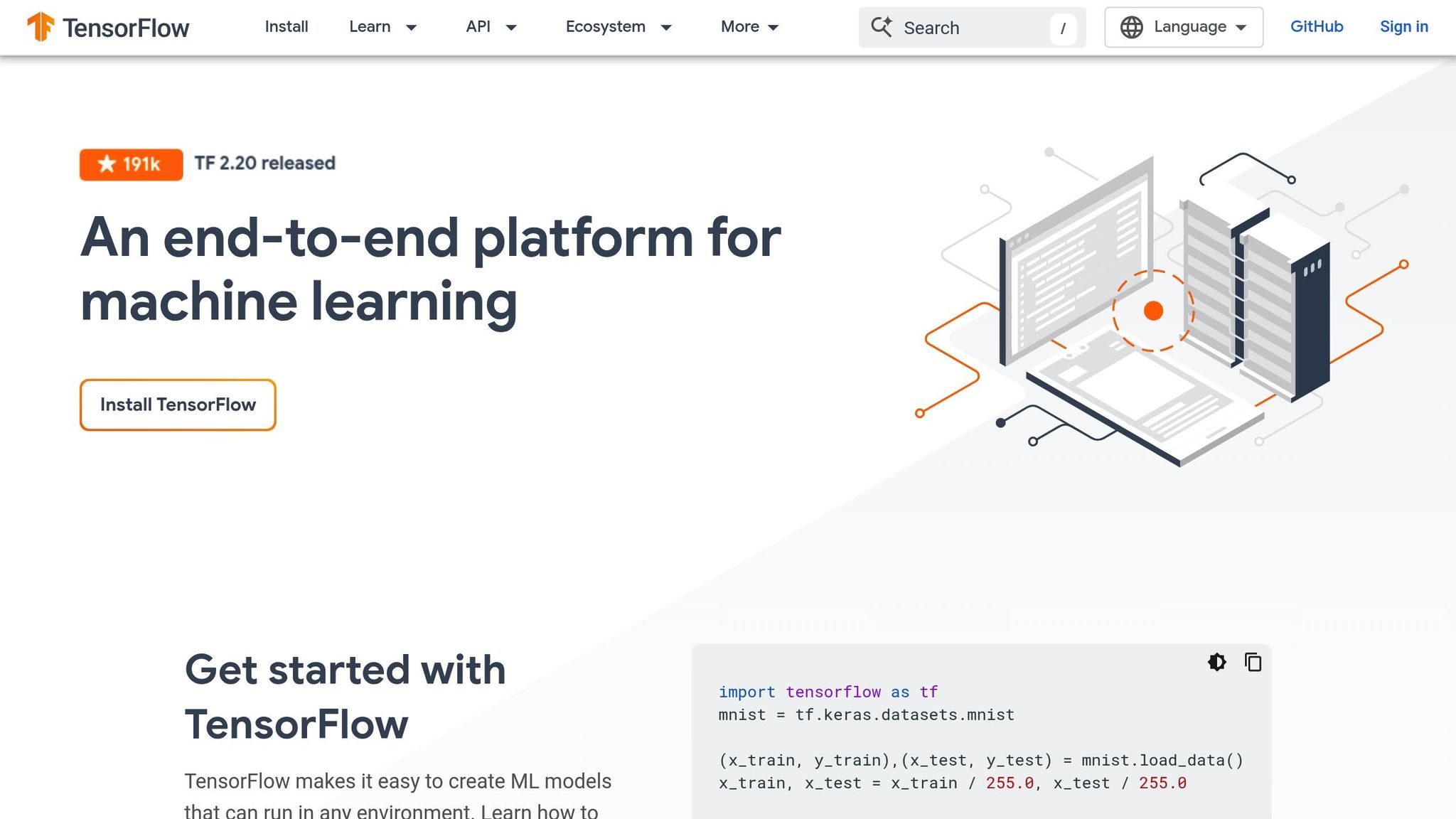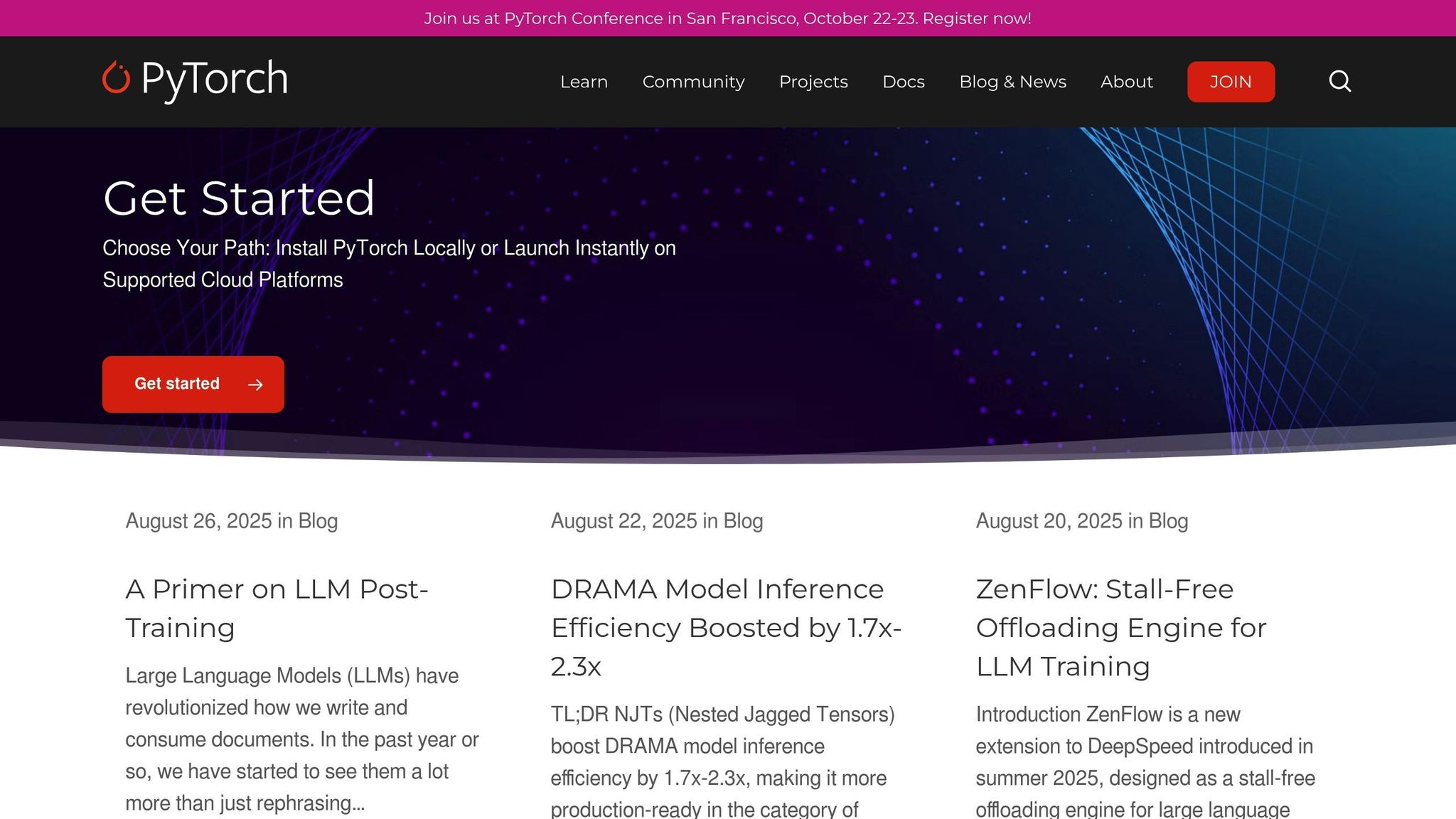Sep 1, 2025
Training massive AI models is challenging, but distributed partitioning makes it manageable. By dividing models and datasets across multiple devices, organizations can train complex neural networks without relying on expensive, high-end GPUs. Here’s how TensorFlow, PyTorch, and NanoGPT handle distributed training:
tf.distribute.Strategy for splitting workloads across GPUs, handling large batch sizes, and managing device failures. It also integrates seamlessly with Google Cloud TPU pods for scaling.torch.distributed package and dynamic computation graphs, ideal for research and prototyping.Each framework has strengths: TensorFlow suits enterprise-scale deployments, PyTorch thrives in research environments, and NanoGPT offers an affordable, streamlined option for focused tasks.
| Framework | Training Speed | Memory Efficiency | Scalability | Cost Effectiveness |
|---|---|---|---|---|
| TensorFlow | High | Very High | Excellent (multi-node) | High |
| PyTorch | Moderate | Moderate | Good (improving) | Moderate |
| NanoGPT | High | High | Good (multi-GPU) | Very High |
Choosing the right tool depends on your goals: enterprise-scale, research-focused, or cost-efficient training.

TensorFlow's tf.distribute.Strategy API is at the heart of its distributed training capabilities, offering tools to efficiently divide workloads across devices. For instance, MirroredStrategy replicates your model across multiple GPUs, ensuring each device processes its share of the data. For larger setups, MultiWorkerMirroredStrategy extends this concept to multiple machines within a cluster.
One of TensorFlow's standout features is its approach to data parallelism. By using all-reduce algorithms, it synchronizes gradients across devices, ensuring model consistency without manual intervention. This makes it particularly effective for training with large batch sizes, where maximizing GPU usage is crucial.
When a model's size surpasses the memory of a single device, TensorFlow employs ParameterServerStrategy. In this configuration, parameter servers manage and update model weights, while worker nodes handle computations like forward and backward passes. While this introduces extra network communication, it allows for training larger and more complex models.
TensorFlow also excels in handling device failures. Its fault tolerance mechanisms ensure that tasks are redistributed if a device goes offline. With checkpointing in place, training can resume from the last saved state, minimizing interruptions and preventing significant data loss.
For those seeking even greater scalability, TensorFlow integrates seamlessly with Google Cloud TPU pods. These pods provide access to hardware specifically designed for large-scale neural network training. With the ability to scale to thousands of cores, TPU pods are particularly effective for transformer models and architectures that rely heavily on attention mechanisms.
Lastly, TensorFlow's profiling tools are invaluable for optimizing distributed training setups. The TensorFlow Profiler delivers detailed insights into device performance, pinpointing delays in communication and imbalances in computation. These insights are key to refining training efficiency. Next, we'll explore how PyTorch tackles distributed partitioning with its own strategies.

PyTorch leverages its torch.distributed package to facilitate multiprocess training across multiple nodes. It integrates support for NCCL (optimized for GPUs), Gloo (designed for CPUs), and MPI for communication between processes.
Building on this, the torch.nn.parallel.DistributedDataParallel (DDP) module enables synchronous training by distributing the model across multiple processes. It ensures that gradients are synchronized across all processes using collective communication methods like all_reduce. Up next, let’s dive into how NanoGPT handles distributed partitioning.

NanoGPT makes use of PyTorch's distributed training capabilities to set up multi-GPU systems. Its train.py script uses torch.nn.parallel.DistributedDataParallel (DDP) to synchronize gradients across GPUs. This synchronization is a key step toward improving memory management and gradient handling in distributed environments.
To handle large datasets efficiently, NanoGPT employs a memory-mapped approach using np.memmap to load .bin files. This method allows the system to scale without running into memory limitations, which is especially important when training across distributed systems. By avoiding memory bottlenecks, it becomes easier to manage the demands of large-scale AI training.
Another feature is gradient accumulation, which enables the simulation of larger batch sizes by accumulating gradients over multiple mini-batches. This approach is particularly useful for training large models when GPU memory is limited.
Checkpointing is also integrated into NanoGPT, allowing the system to save model and optimizer states periodically. This ensures that training can resume smoothly if interrupted, minimizing potential disruptions.
Additionally, NanoGPT takes advantage of PyTorch 2.0's torch.compile to optimize computational graphs. While not specific to distributed training, this feature reduces computational overhead per device, which is especially beneficial when scaling across multiple nodes. The result is improved throughput and efficiency for large-scale training setups.
Now that we've covered the mechanics of distributed partitioning, let’s dive into how different frameworks stack up. Each framework has its own strengths and weaknesses when it comes to managing distributed partitioning for AI training. By understanding these differences, organizations can make better decisions based on their specific goals and limitations.
TensorFlow stands out in production environments due to its well-established ecosystem and powerful distributed training features. Its tf.distribute.Strategy offers enterprise-grade support for distributed training, but the framework’s complexity and reliance on static graphs can make prototyping slower.
PyTorch, on the other hand, shines in research settings thanks to its flexibility and user-friendly interface. Its dynamic computation graphs and DistributedDataParallel feature enable faster prototyping, though this comes at the cost of higher memory usage and a less mature suite of production tools.
NanoGPT offers an efficient, cost-effective solution for multi-GPU training, with a pay-as-you-go pricing model that starts at just $0.10.
Here’s a quick comparison of the frameworks based on key factors:
| Framework | Training Speed | Memory Efficiency | Scalability | Cost Effectiveness |
|---|---|---|---|---|
| TensorFlow | High (optimized graphs) | Very High (XLA supported) | Excellent (multi-node support) | High (efficient resource usage) |
| PyTorch | Moderate (dynamic graphs) | Moderate (higher overhead) | Good (continuously improving) | Moderate (versatile but resource-intensive) |
| NanoGPT | High | High | Good (optimized for multi-GPU setups) | Very High (pay-as-you-go pricing) |
Looking at the numbers, TensorFlow delivers outstanding performance per dollar in large-scale deployments, making it a great choice for enterprise applications. PyTorch excels in environments where rapid development is critical, even though it might consume more resources. Meanwhile, NanoGPT is particularly appealing for organizations that need affordable and flexible AI solutions.
When it comes to memory efficiency, TensorFlow leads the pack with its optimized graph compilation, ensuring excellent memory usage. PyTorch sacrifices some memory efficiency for its dynamic nature, which simplifies debugging and development. NanoGPT, meanwhile, minimizes memory bottlenecks in multi-GPU setups, offering a practical solution for focused training tasks.
In terms of scalability, TensorFlow is a top choice for large-scale distributed training across multiple data centers. PyTorch continues to enhance its distributed capabilities for GPU workloads, while NanoGPT focuses on optimizing single-node, multi-GPU deployments for more targeted scenarios.
Choosing the right framework boils down to your team's training needs and what matters most to your organization.
TensorFlow stands out for large-scale deployments. Its advanced XLA-optimized infrastructure and static graph compilation ensure strong performance and cost efficiency, though it comes with added complexity.
PyTorch shines when speed and flexibility are key. Its dynamic computation graphs and easy debugging make it perfect for rapid prototyping, even if it demands more memory.
NanoGPT is a cost-effective choice for teams working on multi-GPU, single-node setups. Its simple design is ideal for smaller teams looking to train models efficiently without the added layers of enterprise-level systems.
NanoGPT makes distributed AI training simpler and more budget-friendly, especially for smaller teams or solo developers. It’s designed with ease of use and smart resource management in mind, enabling users to train medium-sized GPT models without requiring massive infrastructure or advanced technical skills.
Unlike heavyweight frameworks like TensorFlow or PyTorch, which cater to large-scale operations, NanoGPT focuses on cutting down complexity. This makes it a great option for teams wanting to experiment and push boundaries without breaking the bank or getting overwhelmed by intricate setups.
When choosing between TensorFlow, PyTorch, and NanoGPT for training AI models, it's important to weigh factors like scalability, performance, and ease of use based on your project's requirements.
TensorFlow shines when working with large-scale models and production environments. Its extensive set of tools simplifies deployment, making it a go-to option for enterprise-level applications. PyTorch, with its dynamic computation graphs, is a favorite for research and experimentation. It allows for quicker iteration cycles, which is invaluable when testing new ideas. Meanwhile, NanoGPT is all about simplicity and efficiency. It's particularly useful for training and fine-tuning medium-sized GPT models without unnecessary complexity.
The best choice depends on your project's goals, timeline, and the level of complexity you're prepared to handle.
Gradient accumulation in NanoGPT offers a clever way to train large AI models, even when GPU memory is limited. Rather than handling an entire large batch all at once, the process breaks it down into smaller mini-batches. Gradients are computed for each mini-batch individually and then combined over multiple steps before updating the model's weights. This method mimics the effect of training with larger batch sizes while staying within the hardware's memory constraints.
This technique allows NanoGPT to make the most of available resources, making it possible to train complex models efficiently without sacrificing performance, even on systems with limited memory.